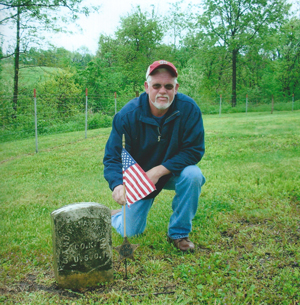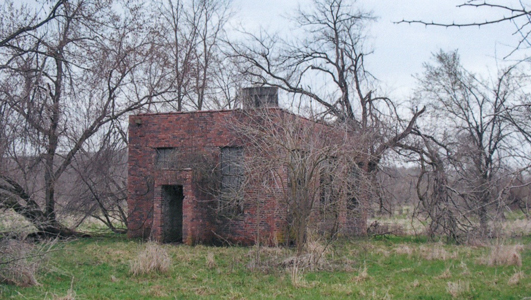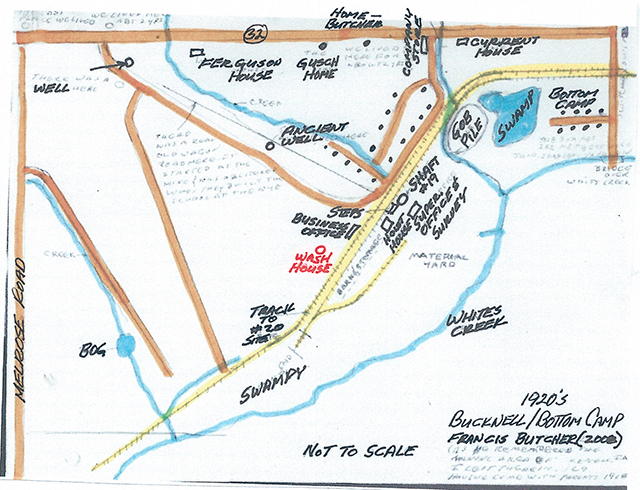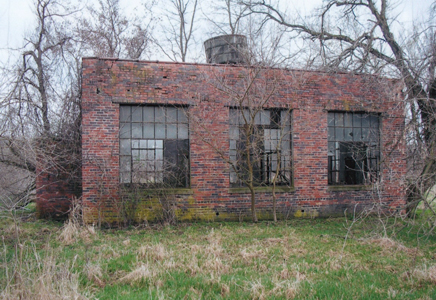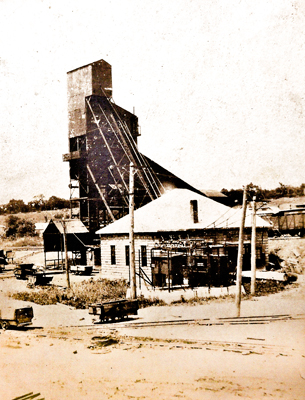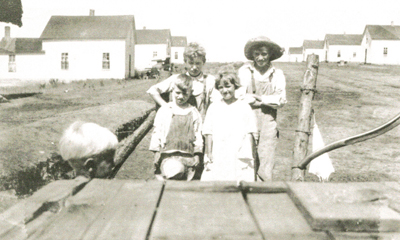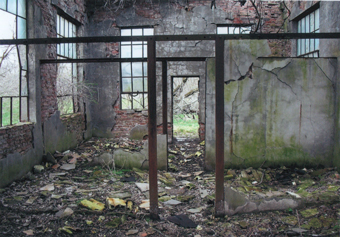
http://www.buxtoniowa.com • Consol, Haydock & Buxton Iowa, USA • 1871 - 2014
The Wash House
'Wash House' Stands as testament to miners long ago
The Albia Union-Republican Thursday, May 10, 2007
by Brian Chambers
Very little is left of the old mining camps and towns of almost a century ago. If one kicks around in the country many concrete foundations will be found or — in the case of Buxton — portions of the old warehouse and bank vault can be seen. Rarely, however, does one come across an almost intact landmark that allows more than just something to trip or sit on. Unless you have seen the wash house in a little-known place named Bucknell.
Bucknell, tucked away in northwest Monroe County, is much like the other towns such as Haydock, Consol, Hiteman, Hocking, Foster, or a host of others where concrete foundations flourish. But it has something the other towns cannot boast — a standing wash house.
Bucknell was created as headquarters of the Consolidation Coal Company when it moved from Buxton in 1918 after Mine No. 18 was opened in nearby Bucknell. In that same time frame, Consolidation started the mining community of Haydock, west of Bucknell.
It gets a little busy when attempting to research the three communities (Consol, Bucknell, and Haydock), but suffice it to say that all were created in the years immediately before Buxton fell from grace, with Bucknell being the company headquarters. By looking at a map of the time headquarters was most likely established there because it was centered between the two and less than a mile west of No. 18, the most profitable mine at the time and one of the two that the company was actively working.
Consolidation had high hopes for Bucknell from the start and described it in a letter published in the Albia Union Republican on Nov. 29, 1921. “This whole townsite is located on a beautiful flat which is destined to be Monroe County’s largest industrial city for the next 20 years.” Such are the dreams of men, especially the capitalists that ran the industry at the time.
But this isn’t about the robber barons that strafed the land and after all the profits that could be obtained were exhausted, moved on. No, this is about the men who worked the mines and where many would congregate after their shift.
It is rare when one can stand inside a place that is more intimate that the was house. Those that have been in the armed services know it, what it is like to shower with up to 20 other soldiers, all naked. Not much left to the imagination at that point with all defenses down conversation flows like the cleansing water.
Standing inside the crumbling structure one can almost hear the conversation amongst the miners. “That was a rough shift today.” “Sure was, hope tomorrow is better.” “How’s Mabel and the baby doing?” “Better, the baby’s had some colic and Mabel took her over to Doc Chester in Haydock. He gave her something for it.”
Or perhaps, since many of the miners were young, a little kidding may have been going on. “Hey guys, did you hear that Glen over there has his hat set for Lydia, old man Houser’s daughter?” “You better back off Glen, the old man will put some buckshot in your hide if he catches you sniffing around.” “Doesn’t bother me any, Lydia’s crazy about me.” “Sure, you said the same about Dorothy and she up and married Hobe. Maybe she seen you in the shower.”
Or maybe the conversation became subdued, especially after an accident such as the one that befell William Clark in December 1923 when the 20-year-old was crushed by a fall of slate and killed instantly. “Too bad what happened to Bill.” “Sure is, he was a good cuss, sure wish I could have got there quicker. Wouldn’t have done much good though, he never knew what hit him, just before Christmas too, his folks goin’ to take it hard.” “Yeah, I wouldn’t put props in on a bet, damn dangerous work. I’ll stay away from company work, take my chances mining.”
As reported in the Union Republic on December 13, 1923 William Clark was killed in a fall of slate in Bucknell mine at about 10 a.m. Clark was employed as a timber-man’s helper and what the miners referred to as “company work.” “At the time of the accident Mr. Clark was employed at putting in new props,” the Union Republican stated. “One of the props had been put in place and the young man thought the place was safe, but while placing another prop he was caught in the fall, several tons of slate falling and terribly crushing and mangling him. Fellow miners rushed to his aid, but all attempts to save his life were useless, as life had gone before he was removed from the fall, death having been instantaneous.”
The article went on to say that “Mr. Clark was popular among his fellow workmen and had many friends who will sincerely sympathize with the parents and other relatives in the untimely death of the young man.”
It is reports such as this one that the wash house lends life to. Who can say that when standing where so many men from the mine had stood, exposed to each other and life, that the conversation wasn’t about William Clark, at least for a few days? To read an old entry in a paper from 90 years ago is one thing, to be standing where others stood in the aftermath of the accident is quite another.
The wash house, a rectangular structure with an entrance at each end, both identical. Inside each entrance a changing room that the miners disrobed in before walking into the center of the building where a cistern is mounted on the roof that held the water to rid them of the dust and grime on the outside. But the water did nothing for the black powder that settled in their lungs in what would come to haunt many of the laborers in the form of black lung disease. And eventually result in death.
When entering the house the presence of these men are felt, in some way they live again. Their voices, long muted, are heard via the imagination. When a hand is placed on the doorway you are reminded of the others that placed their hand in the same spot, now long gone. One could say the wash house offers somewhat of a transcendental experience, and those don’t come along every day.
